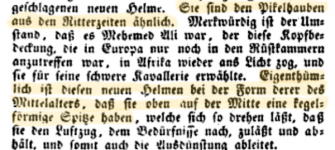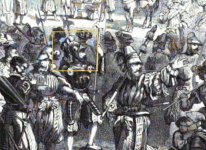Sandmann
Well-known member
Dear friends,
I have revised my article about the invention of the pickelhaube and merged my research from the newspapers and magazines of the mid-19th century with the official state of research. The content is in principle the same as I always had a look at the official story, but I have tidied up the sources and refer to articles only on articles of military journals.
It feels good that the information from the newspaper articles did not lead to any contradictions with the previous official state of research, but fit very well into the previous narrative and close some gaps in knowledge about the invention of the spiked helmet. In order to guarantee the truth of the contents as well as possible, I have only taken into account information that has been published several times and in different newspapers or books. The official narrative has been taken from several editions of the German scientific magazine for military history „Zeitschrift für Heereskunde“, published by „Deutsche Gesellschaft für Heereskunde e. V.“ (German Society for Army Science)
About the invention and introduction of the Pickelhaube in Prussia
Dear native English speakers,
if you notice any mistakes in the grammar, I would be very happy if you would improve me to make the article better.
Thank you in advance.
I have revised my article about the invention of the pickelhaube and merged my research from the newspapers and magazines of the mid-19th century with the official state of research. The content is in principle the same as I always had a look at the official story, but I have tidied up the sources and refer to articles only on articles of military journals.
It feels good that the information from the newspaper articles did not lead to any contradictions with the previous official state of research, but fit very well into the previous narrative and close some gaps in knowledge about the invention of the spiked helmet. In order to guarantee the truth of the contents as well as possible, I have only taken into account information that has been published several times and in different newspapers or books. The official narrative has been taken from several editions of the German scientific magazine for military history „Zeitschrift für Heereskunde“, published by „Deutsche Gesellschaft für Heereskunde e. V.“ (German Society for Army Science)
About the invention and introduction of the Pickelhaube in Prussia
Dear native English speakers,
if you notice any mistakes in the grammar, I would be very happy if you would improve me to make the article better.
Thank you in advance.


